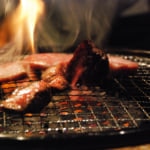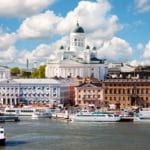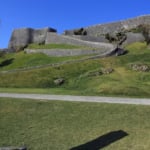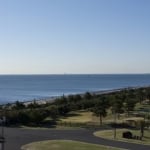Name: Anakena Beach
Address: Anakena Beach, Easter Island, Chile
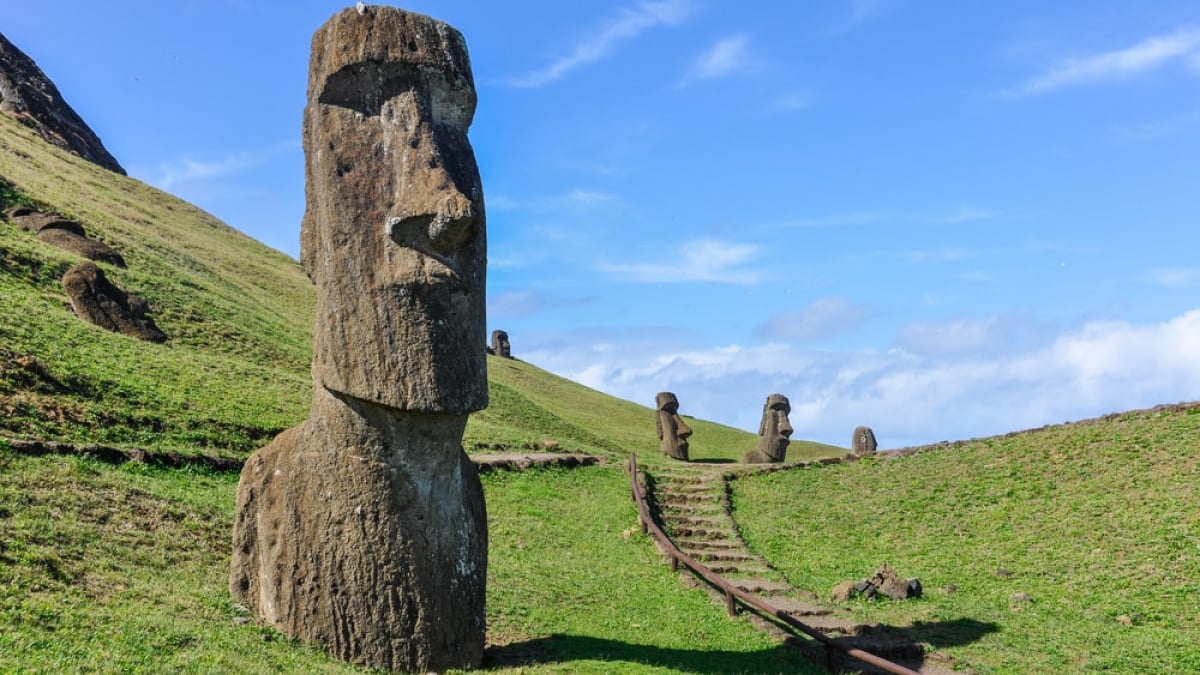
7 Tourist Spots in Easter Island, Chile! The Mysterious Isolated Island Floating in the Pacific
Floating off the coast of Chile in the Pacific Ocean, “Easter Island” is a globally famous isolated island known for its Moai statues, said to have been left behind by an ancient people. It is said that there are about 10,000 Moai statues on the island—more than its human population—and their shapes differ depending on the tribe and the part of the island where they stand.
For what purpose were these giant stone statues made? How were they created? The mystery that still remains unsolved is part of Easter Island’s charm. A transfer is often necessary, a mystical world awaits that can only be experienced by those who make the journey.
table of contents
[x] close
7 Tourist Spots in Easter Island, Chile! The Mysterious Isolated Island Floating in the Pacific
1. Anakena Beach
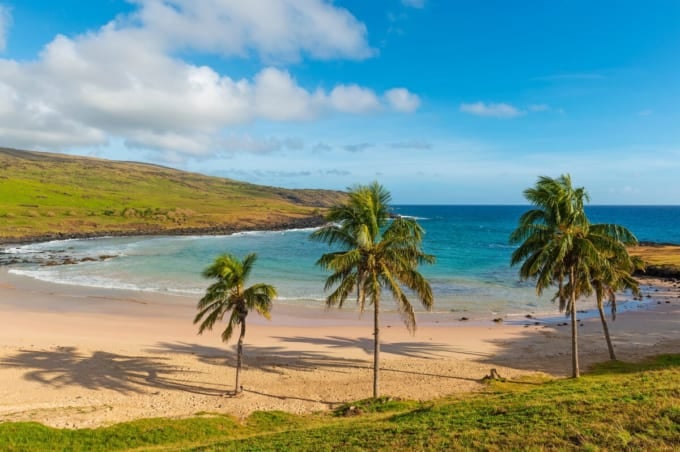
Anakena Beach is the quintessential tropical island beach, with pristine white sand, magnificent palm trees, and crystal-clear waters. The area has two “ahu” (meaning altar in the local language) and still retains Moai statues.
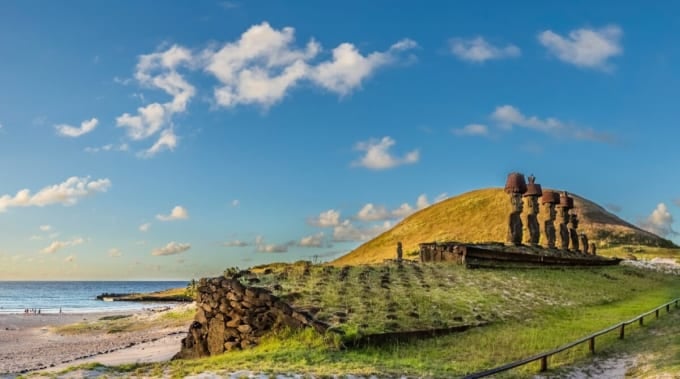
The Moai statues at Anakena Beach were preserved in good condition because they were buried in sand, preventing erosion.
Their facial features are distinct, with clearly defined eyes and noses, and the carvings of dolphins and birds on their backs are still beautifully visible. Some Moai statues wear a red stone topknot called “pukao,” while others stand with palm trees growing nearby—both rare sights. Watching the Moai statues from the water could be another unique experience.
Since Easter Island has few beaches, it’s said that the large equipment, such as cranes used to lift fallen Moai statues back up, were brought in through this beach.
Anakena is not just for tourists—locals from Hanga Roa village also come here for picnics, and you can buy drinks and snacks from small stalls.
2. Orongo Cape
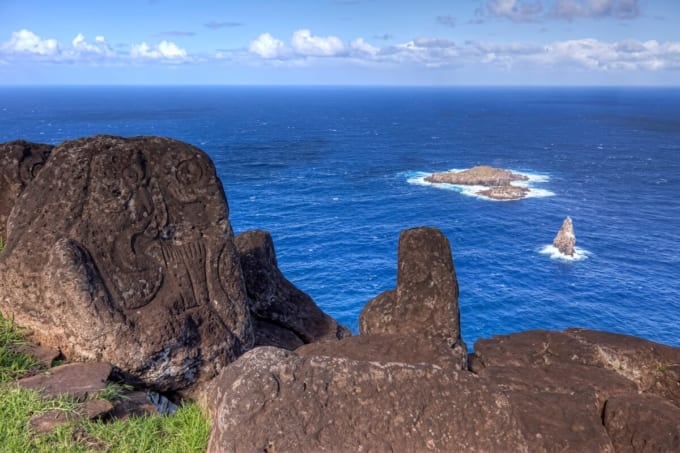
Located on the southern side of the island, Orongo Cape is a place of great religious importance, once the site of the Birdman competition, held on a nearby rocky islet.
This competition, aimed at selecting the “Tangata Manu” (Birdman), took place using Motu Nui, an island offshore, as the stage. Competitors would descend the sheer cliffs of the cape, swim across shark-infested waters to the island, search for the first egg of the season laid by the sooty tern, place it on their head, and swim back—a challenge much like a triathlon.
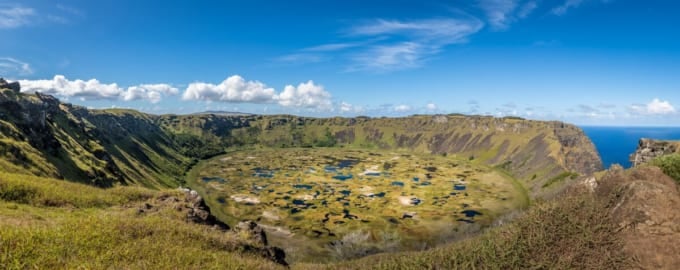
Orongo Cape is also home to the Rano Kau volcano, and from its viewing platform, you can enjoy a panoramic view of “Rano Kau,” the largest caldera lake on Easter Island. The lake’s surface is dotted with a plant similar to reeds called “totora,” creating a beautiful sight. If you visit Orongo Cape, take a little extra time to see it.
Name: Orongo Cape
Address: Orongo, Easter Island, Chile
3. Ahu Tongariki
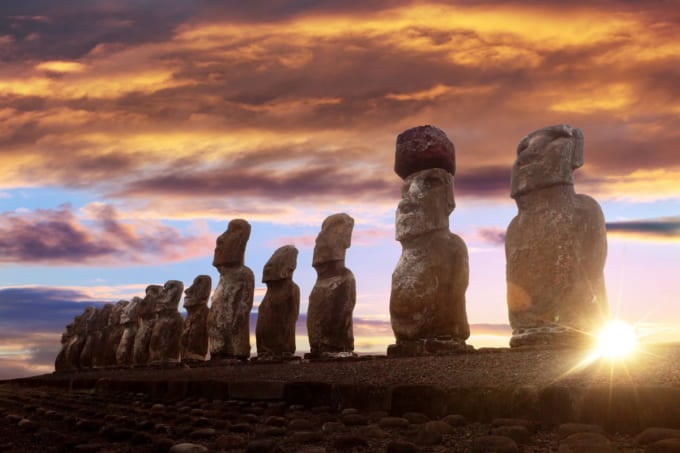
The largest archaeological site on Easter Island, Ahu Tongariki, is a location where 15 Moai statues, each standing over 5 meters tall, line up side by side.
Due to past tribal conflicts and a tsunami, all 15 of these statues had once fallen. However, in 1994, archaeologist Claudio Cristino, with the cooperation of Japanese crane manufacturer Tadano—whose cranes can handle weights up to 55 tons—restored them to their standing positions.
Near the entrance, there is a solitary Moai statue standing alone, called “Hotu Iti.” Nearby, there is also a round stone considered to mark the center of the world. This stone is said to contain a power called mana, so be sure not to miss both when you visit!
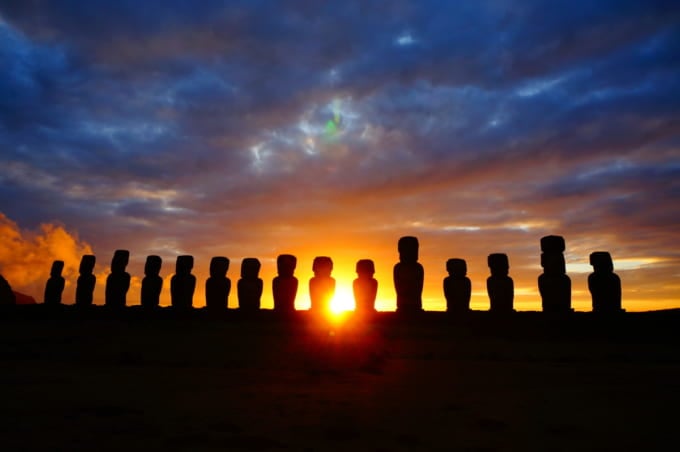
The sight of the 15 Moai statues standing in a row is truly spectacular. The area where Ahu Tongariki is located is believed to have once been the largest settlement on Easter Island.
Since Ahu Tongariki is located on the eastern side of the island, it is also recommended as a sunrise viewing spot, with the sun rising between the statues.
Name: Ahu Tongariki
Address: Ahu Tongariki, Easter Island, Chile
4. Hanga Roa Village
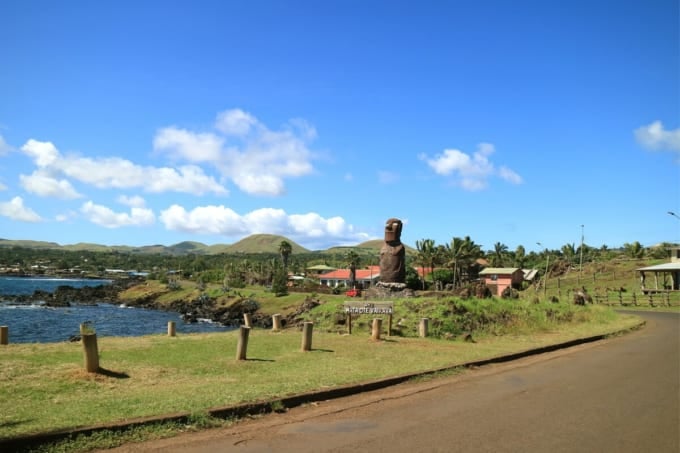
With a population of about 3,800, Hanga Roa Village is the only village on Easter Island, home to roughly 90% of the island’s inhabitants.
This village has essential facilities such as a hospital, police station, school, and bank, as well as recreational spots like the island’s only soccer field and disco club. There are also restaurants, souvenir shops, hotels, and other amenities for visitors.
In the early 20th century, Easter Island was leased to a Scottish livestock company. At that time, the islanders, who originally lived scattered across the island, were gathered into this village—a practice that continues today, with the community centered here.
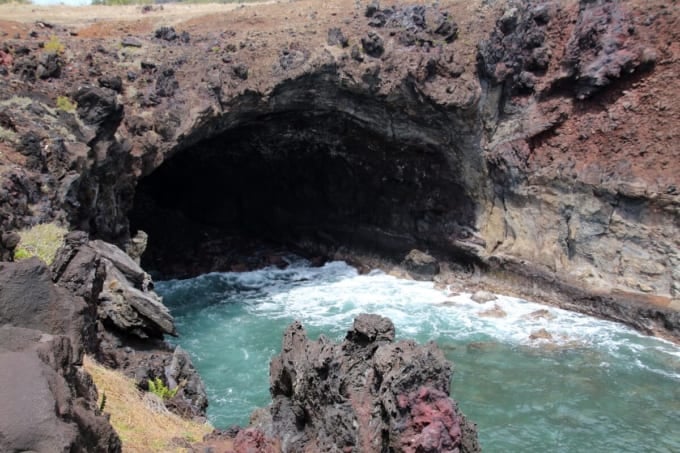
At the base of a cliff on the outskirts of the village lies a cave called “Ana Kai Tangata,” which is said to have been the site of cannibalistic rituals. The cave is not very large, but paintings of birds remain on its ceiling.
Name: Hanga Roa Village
Address: Hanga Roa, Easter Island, Chile
5. Tahai Archaeological Site
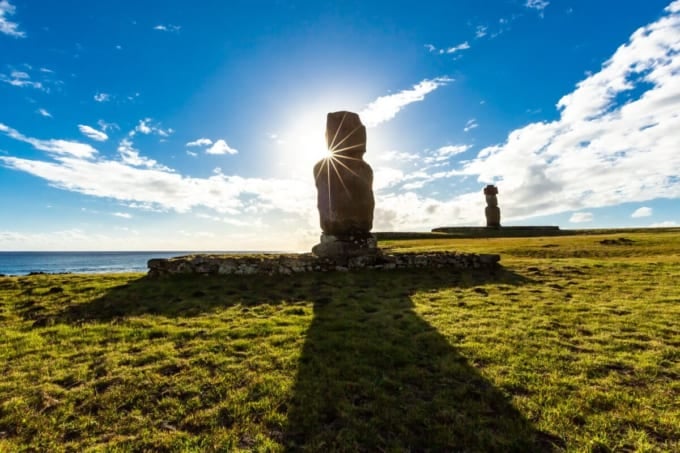
Within walking distance from Hanga Roa Village, the Tahai Archaeological Site is an easily accessible tourist spot. It contains three “ahu” (meaning altar in the local language): Ahu Vai Uri, Ahu Tahai, and Ahu Ko Te Riku.
Vai Uri holds the earliest Moai statues from the initial period, Tahai has those from the middle period, and Ko Te Riku has those from the later period. The shapes of the statues changed over time—earlier ones are rounder, while later ones have longer faces.
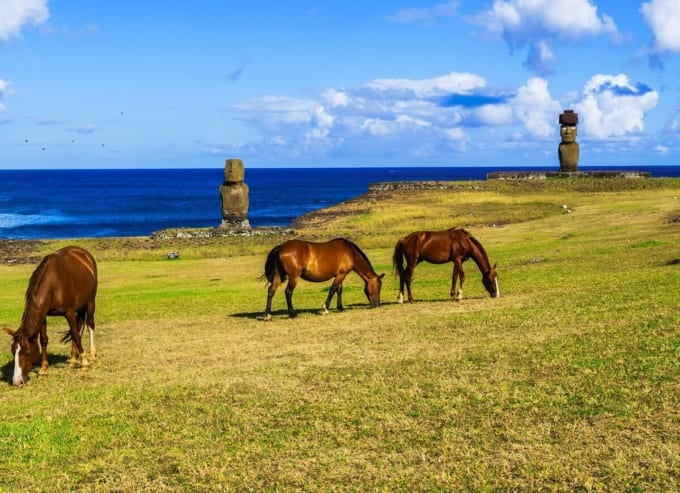
Ko Te Riku is famous for having the only Moai statue on Easter Island with eyes.
It was believed that adding eyes gave the Moai spiritual power to protect the tribe. For this reason, during wars, the eyes were destroyed first to deprive the statues of their power.
At Tahai, you can also see remains of religious ceremony platforms called paenga, dwellings, and chicken coops. Since it is located on the western side of the island, opposite Tongariki, you can enjoy a beautiful sunset sinking behind the Moai statues. Therefore, it is highly recommended to visit Tahai in the late afternoon.
Name: Tahai Archaeological Site
Address: Ahu Tahai, Rapa Nui, Easter Island, Chile
6. Ahu Akahanga
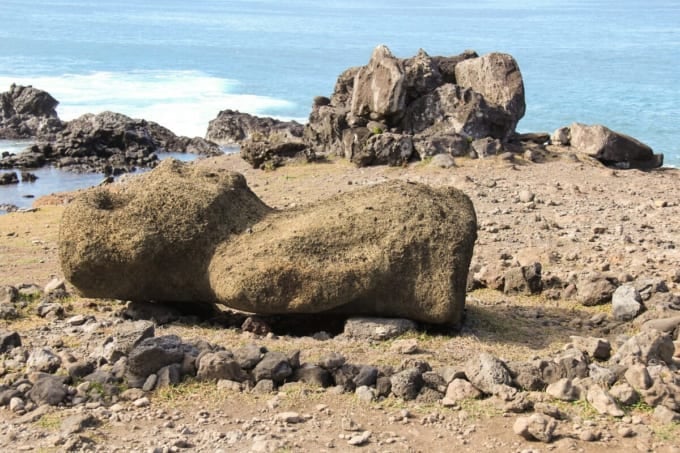
Located in the southern part of Easter Island, the Moai statues at the ruins of Ahu Akahanga are mostly toppled over.
This is the result of the “Moai toppling wars” that took place in the past. For about 50 years, there was conflict between those who created the Moai statues and the island’s inhabitants. It is believed that the increase in population due to Moai construction led to disputes over food and resources among the islanders.
Although toppled Moai statues can be seen in many places around Easter Island, this particular area carries an atmosphere of being a “ravaged land.” Despite its sad history, Ahu Akahanga remains one of the most important sites for learning about the island’s past.
Name: Ahu Akahanga
Address: Ahu Akahanga, Hanga Roa, Easter Island, Chile
7. Rano Raraku
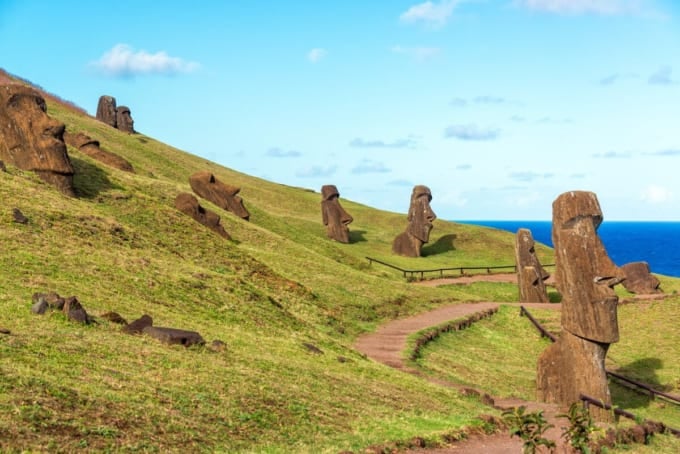
Rano Raraku was both a quarry and the workshop where Moai statues were made. Nearly all of the Moai statues on Easter Island were created here. Some statues remain embedded in the mountainside, never having been fully removed.
The variety here is remarkable—there are upside-down Moai, kneeling Moai, female Moai with chests, smiling Moai, and more. Around 400 Moai statues in various stages of completion remain in their original condition.
This site clearly shows the process of how the Moai were made. It is truly the mountain where the Moai were born! Even just looking around is fascinating, making it one of the most popular tourist spots.
Since visiting involves a bit of hiking, wear comfortable sneakers. The sun can be intense, so don’t forget a hat. This is the perfect place to learn about the behind-the-scenes of Moai production, and it’s fun to try and find your favorite statue. Definitely include it in your Easter Island itinerary.
Name: Rano Raraku
Address: Rano Raraku, Easter Island, Chile
◎ Summary of Recommended Tourist Spots on Easter Island
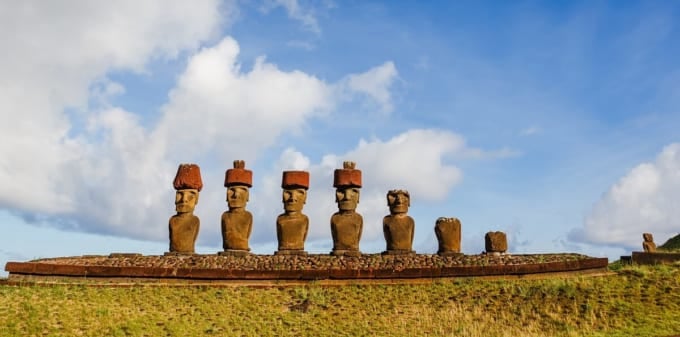
The official name of Easter Island is “Isla de Pascua.” In the local language, it is called “Rapa Nui,” meaning “vast land.” With green grasslands swaying in the wind, a vast blue sky, a deep blue ocean, and Moai statues that seem to draw visitors into a mysterious world—one cannot help but feel that they are gazing into the distance as if trying to convey something.
The island overflows with romance and mystery, and you will surely find yourself captivated by Easter Island.
Easter Island is registered as a UNESCO World Heritage Site under “Rapa Nui National Park.” For details on entry applications, admission fees, and visitor guidelines, refer to the article on the World Heritage “Rapa Nui National Park.” Be sure to check it out and make your way to Easter Island!
RELATED ARTICLES
REGIONS
CATEGORIES
FEATURED ON Chile
-
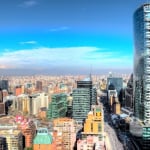
Rich Local Specialties! Representative Souvenirs from Santiago, the Capital of Chile
-
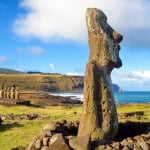
7 World Heritage Sites in South America’s Chile | A Complete Introduction to Chile’s Fascinating Cultural Heritage!
-
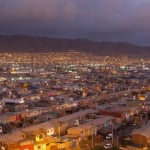
Top 5 Recommended Tourist Spots in Antofagasta, Northern Chile
-
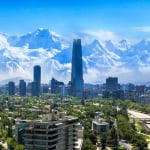
5 Must-See Tourist Spots in Chile! A Country Brimming with Diverse Natural Wonders
-
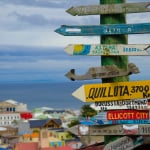
Top 4 Must-Visit Attractions in Punta Arenas, the Southernmost City of South America
MOST POPULAR ON Chile
-
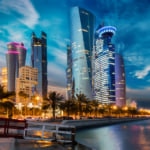 1
1Doha: Must-see Attractions in the Capital of Qatar
-
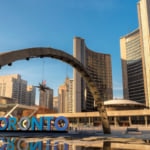 2
2Toronto: 10 Things to do in this Picturesque Canadian City
-
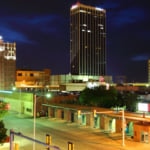 3
3Amarillo: A City Famous for It’s Amazing Canyons, Great History and Music
-
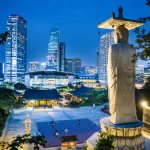 4
4South Korea: Dazzling Scenery, Rich Culture and Fascinating History
-
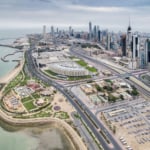 5
5Kuwait: A Country in Middle East Asia Famous for Hot Sand Dunes and Stunning Cityscape

